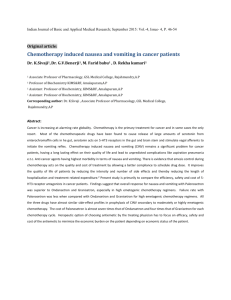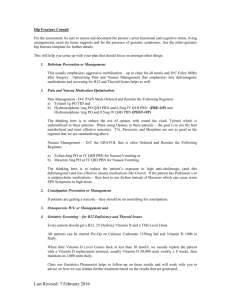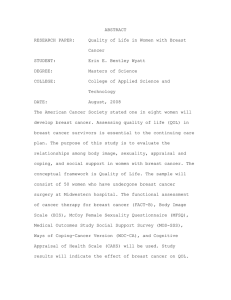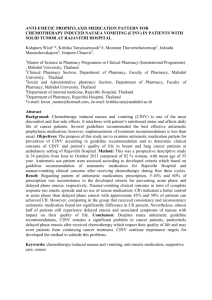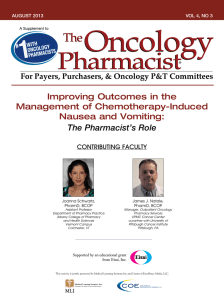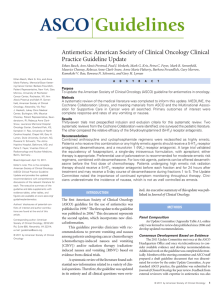Management of Chemotherapy Side Effects in Breast Cancer Patients
advertisement
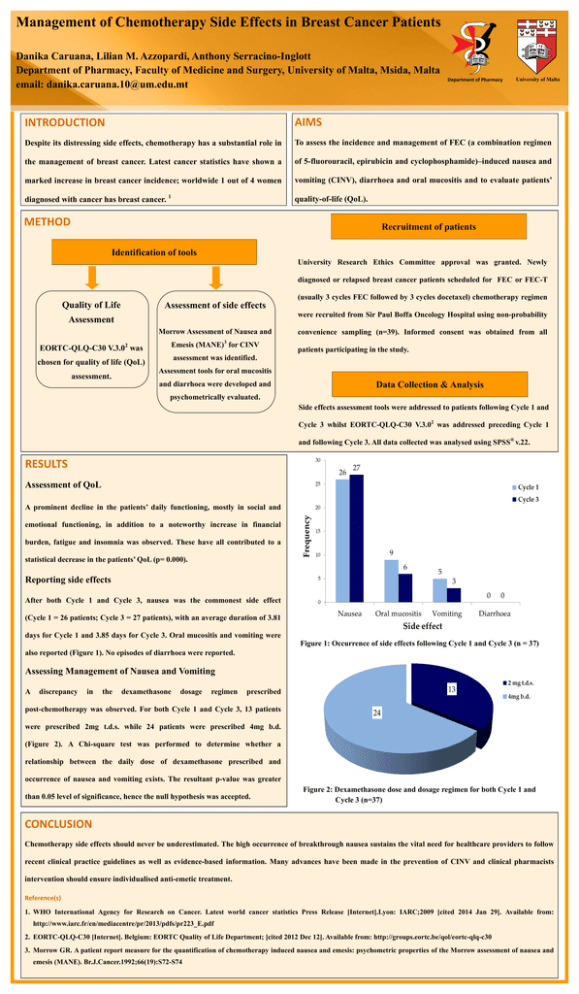
Management of Chemotherapy Side Effects in Breast Cancer Patients Danika Caruana, Lilian M. Azzopardi, Anthony Serracino-Inglott Department of Pharmacy, Faculty of Medicine and Surgery, University of Malta, Msida, Malta email: danika.caruana.10@um.edu.mt DEPARTMENT OF PHARM ACY UNIVERSI TY OF MA LTA Department of Pharmacy University of Malta INTRODUCTION AIMS Despite its distressing side effects, chemotherapy has a substantial role in To assess the incidence and management of FEC (a combination regimen the management of breast cancer. Latest cancer statistics have shown a of 5-fluorouracil, epirubicin and cyclophosphamide)–induced nausea and marked increase in breast cancer incidence; worldwide 1 out of 4 women vomiting (CINV), diarrhoea and oral mucositis and to evaluate patients’ diagnosed with cancer has breast cancer. 1 quality-of-life (QoL). METHOD Recruitment of patients Identification of tools University Research Ethics Committee approval was granted. Newly diagnosed or relapsed breast cancer patients scheduled for FEC or FEC-T Quality of Life Assessment of side effects were recruited from Sir Paul Boffa Oncology Hospital using non-probability Assessment Morrow Assessment of Nausea and 2 EORTC-QLQ-C30 V.3.0 was Emesis (MANE)3 for CINV assessment was identified. chosen for quality of life (QoL) assessment. (usually 3 cycles FEC followed by 3 cycles docetaxel) chemotherapy regimen convenience sampling (n=39). Informed consent was obtained from all patients participating in the study. Assessment tools for oral mucositis and diarrhoea were developed and Data Collection & Analysis psychometrically evaluated. Side effects assessment tools were addressed to patients following Cycle 1 and Cycle 3 whilst EORTC-QLQ-C30 V.3.02 was addressed preceding Cycle 1 and following Cycle 3. All data collected was analysed using SPSS® v.22. RESULTS Assessment of QoL A prominent decline in the patients’ daily functioning, mostly in social and emotional functioning, in addition to a noteworthy increase in financial burden, fatigue and insomnia was observed. These have all contributed to a statistical decrease in the patients’ QoL (p= 0.000). Reporting side effects After both Cycle 1 and Cycle 3, nausea was the commonest side effect (Cycle 1 = 26 patients; Cycle 3 = 27 patients), with an average duration of 3.81 days for Cycle 1 and 3.85 days for Cycle 3. Oral mucositis and vomiting were Figure 1: Occurrence of side effects following Cycle 1 and Cycle 3 (n = 37) also reported (Figure 1). No episodes of diarrhoea were reported. Assessing Management of Nausea and Vomiting A discrepancy in the dexamethasone dosage regimen prescribed post-chemotherapy was observed. For both Cycle 1 and Cycle 3, 13 patients were prescribed 2mg t.d.s. while 24 patients were prescribed 4mg b.d. (Figure 2). A Chi-square test was performed to determine whether a relationship between the daily dose of dexamethasone prescribed and occurrence of nausea and vomiting exists. The resultant p-value was greater than 0.05 level of significance, hence the null hypothesis was accepted. Figure 2: Dexamethasone dose and dosage regimen for both Cycle 1 and Cycle 3 (n=37) CONCLUSION Chemotherapy side effects should never be underestimated. The high occurrence of breakthrough nausea sustains the vital need for healthcare providers to follow recent clinical practice guidelines as well as evidence-based information. Many advances have been made in the prevention of CINV and clinical pharmacists intervention should ensure individualised anti-emetic treatment. Reference(s) 1. WHO International Agency for Research on Cancer. Latest world cancer statistics Press Release [Internet].Lyon: IARC;2009 [cited 2014 Jan 29]. Available from: http://www.iarc.fr/en/mediacentre/pr/2013/pdfs/pr223_E.pdf 2. EORTC-QLQ-C30 [Internet]. Belgium: EORTC Quality of Life Department; [cited 2012 Dec 12]. Available from: http://groups.eortc.be/qol/eortc-qlq-c30 3. Morrow GR. A patient report measure for the quantification of chemotherapy induced nausea and emesis: psychometric properties of the Morrow assessment of nausea and emesis (MANE). Br.J.Cancer.1992;66(19):S72-S74
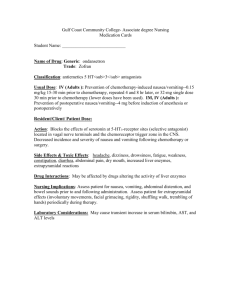

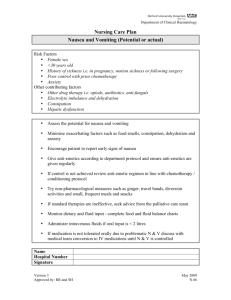

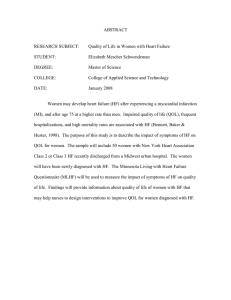
![[Physician Letterhead] [Select Today`s Date] . [Name of Health](http://s3.studylib.net/store/data/006995683_1-fc7d457c4956a00b3a5595efa89b67b0-300x300.png)
